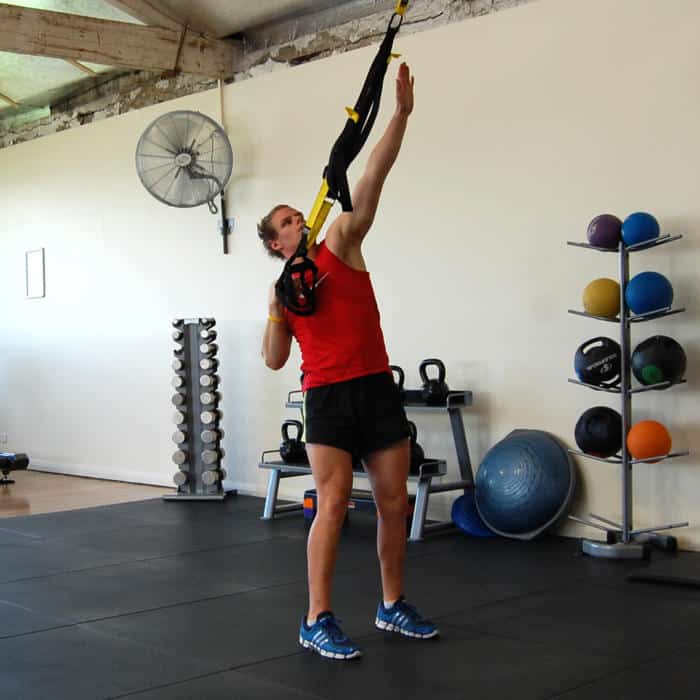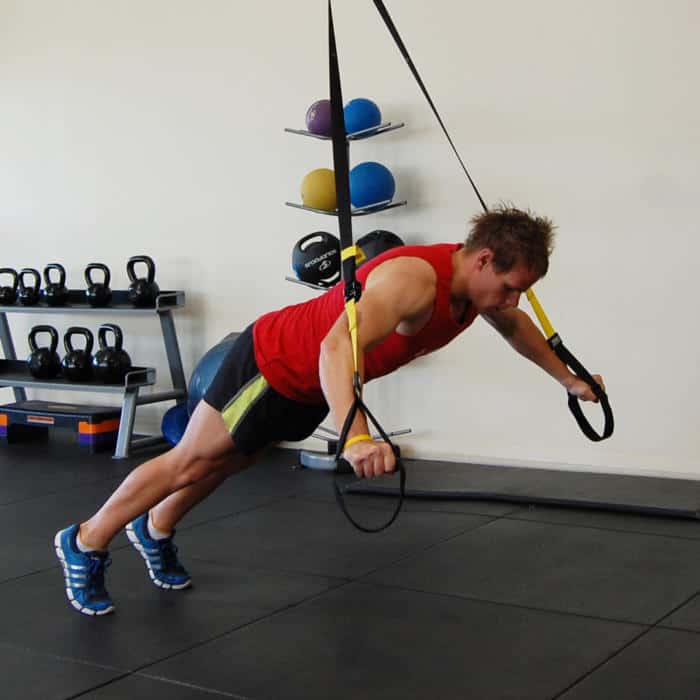
TRX Plank
The TRX Plank exercise takes the regular plank position, from a stable floor environment, and adds a suspended leg variation to it, by putting your feet in the TRX straps. This adds another core stability to this basic stability exercise.

The TRX Plank exercise takes the regular plank position, from a stable floor environment, and adds a suspended leg variation to it, by putting your feet in the TRX straps. This adds another core stability to this basic stability exercise.

The TRX Oblique Crunch is a very dynamic, somewhat pendular exercise, obviously working the core, along with shoulder stability. The bonus of this exercise, is the pendular type of movement, that places more emphasis on the Frontal/ side-to-side axis of movement.

The TRX Wide dip exercise takes the already difficult bar dip exercise, which is somewhat stable and adds an unstable element to it, similar to using the rings in gymnastics. Because of this, there is greater shoulder stability that is required from this movement.

The TRX Low Row is similar to the TRX Inverted Row (see #4). The main difference is the pulling trajectory, which is lower than the former exercise. This will help keep the emphasis on the lats, as well as the mid to lower traps.

The TRX Wide Grip Rows is similar to the Low Row and Inverted Row. The major difference is the arms are abducted at about 45-75 degrees, which takes the Latissumus Dorsi out of the equation and puts more stress an the Rear Delts, Rhomboids, and Middle/Lower Traps. That makes this exercises biomechanically more difficult to execute,

The TRX Power Pull is of benefit in two ways: 1. This exercise is of a rotational nature, meaning that you are working on a Transverse plane, as opposed to the usual Saggital or Frontal plane. Most of the movement we do tend to be in the Saggital plane, like running, pushing, pulling, etc.

Te TRX Single-Arm Row is a unilateral exercise, meaning, you are working one side/ one arm at a time. This will help you to focus on one side/arm at a time, in order to help balance out the body, as we tend to be stronger on one side over the other.

The TRX tabletop row is a derivative of the TRX Inverted Row and the TRX Low Row, with the arm position of the TRX Wide Grip Row. The defining position of this exercise is the ‘tabletop’ position. which automatically makes the exercise more difficult than the aforementioned ones.

The TRX Push Up a shoulder stability challenge to the regular pushup, plus it allows you to get a fuller range of motion, similar to a cable flye or pec deck machine, for added muscle stimulation.

The TRX Chest flye resembles a cable flye, or even a pec deck type flye. It is less of a compound exercise as the TRX push Up, which means the triceps and shoulders are not assisting with this movement. Because of this, the angle at which you will position yourself in order to effectively perform.

The TRX Pike Push Up is to movements in one exercise: a pike position, then a pushup. Having the TRX straps hooked on the feet as opposed to the hands creates more of a challenge for your core muscles, as opposed to just the upper body.

The TRX Pallof Press may appear to be a bilateral exercise, however, it needs to be performed on either side to be balanced. Although it appears to be a dynamic exercise, there is an isometric portion to this movement, offering a unique way to stabilize the shoulder girdle.
© 2024 All rights reserved